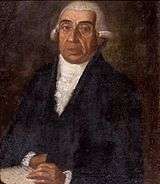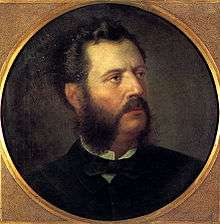Heptanese School (literature)
The term Heptanese School of literature (Greek: Επτανησιακή Σχολή, literally: "The School of the Seven Islands", also known as the Ionian School) denotes the literary production of the Ionian Island's literature figures from the late 18th century till the end of the 19th century. The center of this production is considered to be the poet Dionysios Solomos, so its periods are conventionally divided as follows: Pre-Solomian poets (Προσολωμικοί ποιητές), Solomian poets, Post-Solomian poets, Minors and Descendants.

Antonios Matesis
Bust of Lorentzos Mavilis in Athens
General traits
Some general traits of the Ionian style were:
- the use of Dimotiki instead of Katharevousa (with some exceptions, mainly Kalvos),
- the manifest influence that the contemporary Italian poets had in its thematology, that is regarding the depiction of real-life scenes,
- the worship of homeland,
- the worship of nature,
- a "romantic impulse" (also described as folkloric idealism),
- an emphasis on the importance of love and freedom,
- an appreciation of religion's role in man's life.
Notable representatives
- Mikelis Avlichos
- Andreas Kalvos
- Andreas Laskaratos
- Antonios Martelaos
- Gerasimos Markoras
- Antonios Matesis
- Lorentzos Mavilis
- Iakovos Polylas
- Dionysios Solomos
- Georgios Tertsetis
- Aristotelis Valaoritis
- Ioannis Zambelios
Notable works
- Hymn to Liberty (1823) by Dionysios Solomos (national anthem of Greece)
- The Free Besieged by Solomos
- Vasilikos (1859), play by Antonios Matesis
- The mysteries of Cephalonia (1872) by Andreas Laskaratos
- Idou o anthropos (1886) by Andreas Laskaratos
gollark: *I* disbelieve free will too!
gollark: Look, since you've been gollark, you will be gollark, which is only possible if you are gollark, so you're gollark.
gollark: Exactly the kind of ridiculous, bad argument I would make.
gollark: I don't think so.
gollark: I use a bunch of simple statistical models to predict the content of a message.
References
- Beaton, Roderick. "An Introduction to Modern Greek Literature", Oxford University Press, USA, 1999.
- Πολίτης Λ., "Ιστορία της Νεοελληνικής Λογοτεχνίας" (History of Modern Greek Literature), XI ed., ed. Μ.Ι.Ε.Τ. (National Bank of Greece Cultural Foundation), Athens, 2001. (in Greek)
- Lambert, Juliette (1880). "Poètes grecs contemporains: École ionienne" [Contemporary Greek Poets: Ionian School]. La Nouvelle Revue (in French). Paris. pp. 368–377. ISSN 0184-7465. Retrieved 30 June 2011.
This article is issued from Wikipedia. The text is licensed under Creative Commons - Attribution - Sharealike. Additional terms may apply for the media files.
